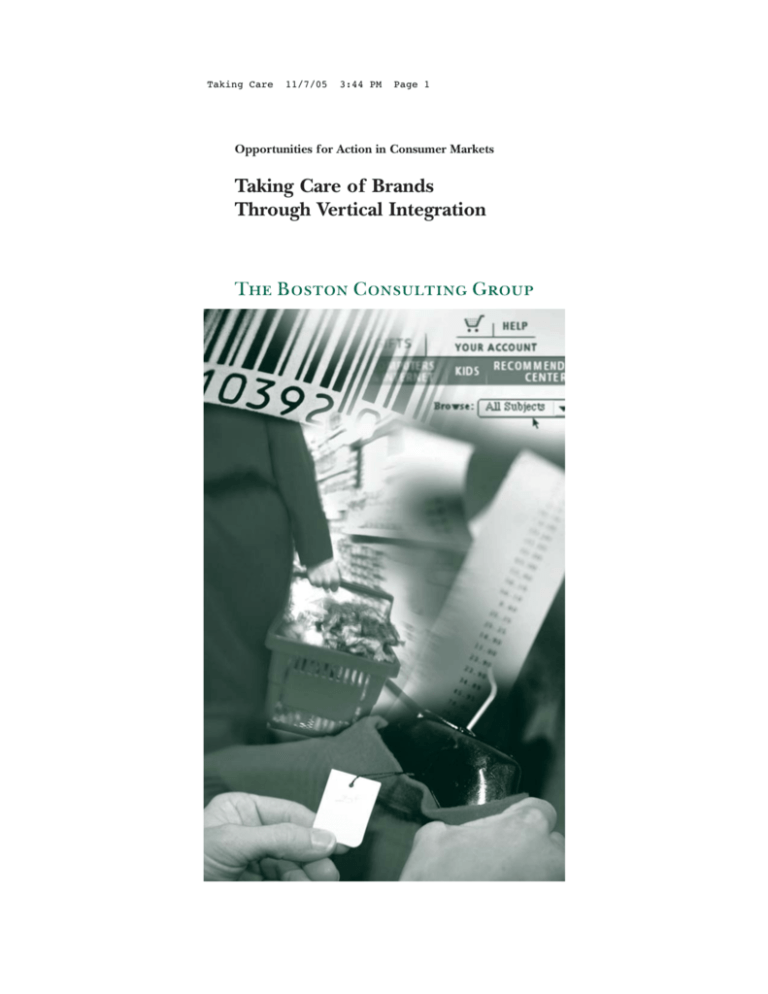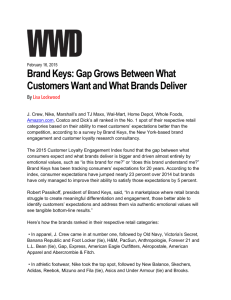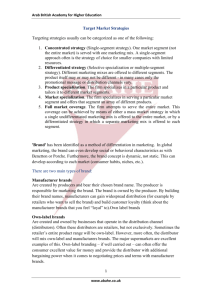
Taking Care
11/7/05
3:44 PM
Page 1
Opportunities for Action in Consumer Markets
Taking Care of Brands
Through Vertical Integration
Taking Care
11/7/05
3:44 PM
Page 3
Taking Care of Brands
Through Vertical Integration
Esprit, H&M, Zara, and other vertically integrated
brands have captured significant market share over
the past few years, growing more rapidly than traditional manufacturers and retailers. By controlling the
whole value chain, from manufacturing to retail—and
thereby blending product and retail identity—vertical
brands can offer attractive economics. With traditional retail channels on the decline, many manufacturers—especially those in textiles, furniture, leather
goods, sporting goods, and luxury goods—are choosing vertical integration as a way to better manage
their brands.
There are, however, many approaches to vertical integration. To get a closer look at the risks, benefits, and
best practices of the various approaches, The Boston
Consulting Group conducted a detailed survey among
a number of leading brands. This article presents
highlights from that study.
Why Vertical Integration Now?
In a traditional business system, the producer controls
product design and development, manufacturing,
selling and distribution to retailers, product service,
and advertising, whereas the retailer is responsible for
store concept and design, store management, product
assortment, visual merchandising, and selling to consumers. But traditional retailers, especially department stores, are facing formidable challenges these
days. Caught between two types of competitors—specialty boutiques on one side and discounters on the
other—retailers are hard-pressed to give the products
Taking Care
11/7/05
3:44 PM
Page 4
they carry the attention they need or deserve. All too
often, consumers find overflowing shelves, messy
salesrooms, out-of-stock merchandise, thin assortments, illogical floor arrangements, and a lack of service at the point of sale. Brand identity—a manufacturer’s most precious asset—is severely compromised
or completely lost in such an environment.
What’s more, manufacturers complain that despite the
prevalence of electronic data interchange, retailers
typically fail to provide them with useful information
about inventory turnover, price realization, and sales
by product group. Given these frustrations, the solution for an increasing number of producers is to seek
more control over the fate of their brands by moving
into the retailing side of the value chain. After talking
with senior managers at companies that have chosen
this option, we compiled a comprehensive set of criteria that other manufacturers might use to assess their
opportunities for vertical integration. (See the exhibit
“Success Factors for Vertically Integrated Brands.”)
But retail, as the industry saying goes, is detail. Even if
you decide that vertical integration is right for your
company, getting all the parts in place is incredibly
challenging. That’s why manufacturers should look at
the whole range of approaches to vertical integration
and assess the opportunities and risks in light of their
own strengths and weaknesses.
Advantages of Vertical Integration
In a traditional store, a consumer is unlikely to pick
two products of the same brand off a rack displaying
several brands unless the labels are prominent. But at
a Benetton, Ikea, or Geox store, for example, choosing the brand of a single manufacturer is unavoidable
Taking Care
11/7/05
3:44 PM
Page 5
because store brand and product brand are one and
the same.
Vertical brands also have a promotional advantage.
One advertisement can serve both the product and
the store, and vertical brands can attract consumers
with prime store locations, pleasing store designs, and
the free publicity such stores often provide. And
because the brand’s owner controls the entire value
chain, it can avoid delays and friction costs between
production and sales. As a result, vertical brands can
respond very rapidly to changes in demand, which
gives them an especially strong advantage in fashion
goods and fresh foods.
Finally, vertical brands are unique in their ability to
offer a harmonious brand gestalt and consistent product positioning. Owners of vertical brands can ensure
that their products are sold in the right environment,
with the right visual merchandising—specifically, with
consistent colors, lighting, and other design elements
in all their stores and consistent packaging for all
their products. And they can provide coherent, comprehensive product offerings with no redundancy. But
whether a manufacturer chooses to set up shop in a
store of its own or in a corner of another retailer’s
store—or to do some of both—is a decision that
requires careful consideration.
Vertical Integration with a Retail Partner
Vertical integration doesn’t necessarily involve opening one’s own store. Shop-in-shops (SiS) and concessions are two formats that allow manufacturers to
continue to benefit from the retailer’s traffic while
capitalizing on the advantages of vertical brands. The
SiS approach—in which a portion of a retailer’s store
Taking Care
11/7/05
3:44 PM
Page 6
is dedicated to a particular brand—has become much
more common over the past five years. It gives the
manufacturer greater control over the presentation of
its brand, but the traditional division of responsibilities between retailer and manufacturer remains
unchanged. Retailers still purchase the merchandise
and bear the inventory risk. Manufacturers are still at
one remove from consumers. Instead of gathering
insights for innovation or merchandising directly
from consumers, they must depend on the retailer to
provide such information, which often is not forthcoming.
Many companies view the SiS and concession formats
as win-win opportunities for manufacturers and retailers alike, offering advantages in sales productivity and
selling competence for both parties. Indeed, some
brand producers that migrated first to directly operated stores have since streamlined their outlet portfolios and are now focusing on SiS and concessions
instead.
Consequently, more and more SiS manufacturers are
moving to the concession format. Under this model,
too, some of a retailer’s store is dedicated to a specific
brand, but the manufacturer bears the full risks of
inventory. Manufacturers can also employ their own
personnel, use their own data systems, and enjoy
many of the benefits of vertical integration.
A number of manufacturers have found success by
establishing their own directly operated stores. These
run the gamut from factory outlets on the discount
side to standard stores to flagships on the high end.
Of the three types, flagship stores seem to be what
every CEO dreams of. Whether it’s Calvin Klein in
Paris, Jil Sander in New York City, Dolce & Gabbana
Vertical Integration
with Directly Operated Stores
Success Factors for Vertically Integrated Brands
Category
characteristics
Big-ticket items
Brand
characteristics
Strong brand (or a strategy
to create one)
“Destination” items
Loyal customers
High consumer involvement
Premium prices
Strong emotional
component in the
purchasing decision
Need for expert advice
Need for after-sales service
Range of offerings
High inventory and
storage risks
Importance of direct
customer feedback
SOURCES: Interviews with experts; BCG analysis.
Company
characteristics
Strong financial position
• Ability to finance the
setup costs of a retail
network
• Cash available to cover
temporary sales dips
Diversification into new
categories
Experience with retail
operations
Global presence in
emerging markets
Market
dynamics
Importance of time to
market
Rapidly changing consumer
needs or tastes
Growing impact of
short-term trends
High rate of innovation
Need for sales transparency
High share of impulse buys
Competitive
environment
Fierce competition
Growing number of annual
product lines
Category not well developed
by retailers
Retail partners not cooperating (poor information
exchange and point-of-sale
promotions)
Messy and disorganized
points of sale
Taking Care
11/7/05
3:44 PM
Page 8
in Los Angeles, or Versace in Miami, these showy
palaces—which display the brand as a work of art—
create a lot of buzz in the shopping world. And
because flagship stores can deliver the full brand
experience through spectacular visual merchandising,
extraordinary customer service, and breadth of product assortment, they attract other retailers that may
want to carry the brand.
Although some manufacturers worry that integrating
into retail may create a conflict of interest with other
retailers they supply, in fact it often proves an advantage because it creates a brand platform that increases sales everywhere. A strong concept can keep consumers coming back and provide an opportunity for
deeper market research. Because contact is direct and
immediate, manufacturers can acquire valuable consumer insights to improve their products.
But flagship stores are expensive, and many of them
are not profitable. Their pricey interiors mean high
depreciation, their prime locations mean high rents,
and their attentive service means high personnel
costs. They can have nearly three times the selling
space of a standard store, with only double the sales.
Not that these stores can’t be worth the investment:
successful flagships contribute enormously to a
brand’s image and therefore indirectly to sales. But
from a financial perspective, they ought to appear in
the marketing and communications budget rather
than in the profit-and-loss statement.
Success Factors for a Directly Operated
Retail Store
Directly operated stores often realize gross margins
higher than those of either traditional retailers or
other vertically integrated formats because they con-
Taking Care
11/7/05
3:44 PM
Page 9
trol the selling process through their own staff. But
before a manufacturer opens such stores, it must
decide on the degree of central management that it
wants to establish. The advantages of centralized decision making include uniformity in visual merchandising, product assortment, service level, and personnel
training. The manufacturer can determine which
products will have priority in which of its stores, forecast sales demand with greater ease, and benefit from
economies of scale.
But too much centralization can shortchange regional
preferences, undermine the motivation of local managers, and increase the cost of monitoring. In general, we have found that both high-end and discount
stores fare better with centralized management of
merchandising, product assortment, and sales planning. Midrange stores often do better with more freedom at the regional level.
Because they control both production and retail,
managers of successful directly operated stores can
take advantage of a pull-driven system in which they
can quickly follow up on consumers’ responses to
their products. By segmenting their product assortment into established products that are continually
replenished, seasonal products, and new products
whose appeal is being tested, they can ensure that
they are providing consumers with the products they
want, at the right time and price, with no out-ofstocks.
Directly operated stores can also be a platform for
diversification into other categories. Montblanc, for
example, opened its own retail stores in 1990 to sell
writing instruments (its core product category), then
launched a line of leather goods in 1995, jewelry for
men in 1996, watches in 1997, fragrances in 2001, and
jewelry for women in 2005. Starting with one store
Taking Care
11/7/05
3:44 PM
Page 10
over a decade ago, Montblanc has developed into a
retail network of more than 250 directly operated
stores around the world—one of the largest networks
in the luxury industry.
Because vertical brands have both a retail and a product identity, the quality of interaction with customers
can be a key source of competitive advantage—but it
also has the potential to cause problems. The store
environment, the skills of the salespeople, and any
printed materials that are distributed can all affect
the brand’s identity. Managers must have the ability,
in particular, to attract and manage a talented sales
staff. That requires an incentive plan that stresses
both the development of skills and the monitoring
of individual goals.
Franchising can be a smart move for established vertical brands. In a franchise, two legally independent
partners agree to cooperate. The franchisee pays for
the use of the brand, for sourcing, and for both the
product and retail concept. The franchise fee
depends on product turnover. The franchise owner
provides the concept and training as well as support
and advertising. Franchising generally permits more
rapid growth than a directly operated store, but it can
compromise the brand image if it isn’t managed carefully. That was the experience of Benetton, for example, which entered the United States with franchises
and has since moved increasingly to directly operated
stores. But many others have found success with franchises, including Accor, Esprit, Levi Strauss, Marc
O’Polo, McDonald’s, Starbucks, Tom Tailor, and Yves
Rocher.
* * *
Many manufacturers are coming to realize that their
brands are too valuable to be left for others to man-
Taking Care
11/7/05
3:44 PM
Page 11
age at the point of sale. Vertical integration offers
many options, with varying levels of risk and opportunity, for manufacturers to explore. Companies should
use a formal framework to evaluate their prospects for
success with this strategy. The goal is to produce a
detailed picture of the gains and pains they will face
in moving to retail operations. Manufacturers that
make an effort to carefully weigh the different
approaches to vertical integration will find it well
worth their time.
Berndt Hauptkorn
Joe Manget
Stefan Rasch
Berndt Hauptkorn is a manager in the Munich office of The
Boston Consulting Group. Joe Manget is a vice president
and director in the firm’s Toronto office. Stefan Rasch is a
vice president and director in BCG’s Munich office.
You may contact the authors by e-mail at:
hauptkorn.berndt@bcg.com
manget.joe@bcg.com
rasch.stefan@bcg.com
To receive future publications in electronic form about this
topic or others, please visit our subscription Web site at
www.bcg.com/subscribe.
© The Boston Consulting Group, Inc. 2005. All rights reserved.
Taking Care
11/7/05
Amsterdam
Athens
Atlanta
Auckland
Bangkok
Barcelona
Beijing
Berlin
Boston
Brussels
Budapest
Buenos Aires
Chicago
Cologne
Copenhagen
Dallas
Düsseldorf
Frankfurt
Hamburg
Helsinki
Hong Kong
3:44 PM
Houston
Jakarta
Kuala Lumpur
Lisbon
London
Los Angeles
Madrid
Melbourne
Mexico City
Miami
Milan
Monterrey
Moscow
Mumbai
Munich
Nagoya
New Delhi
New York
Oslo
Paris
Prague
Page 12
Rome
San Francisco
Santiago
São Paulo
Seoul
Shanghai
Singapore
Stockholm
Stuttgart
Sydney
Taipei
Tokyo
Toronto
Vienna
Warsaw
Washington
Zürich
BCG
www.bcg.com
11/05









